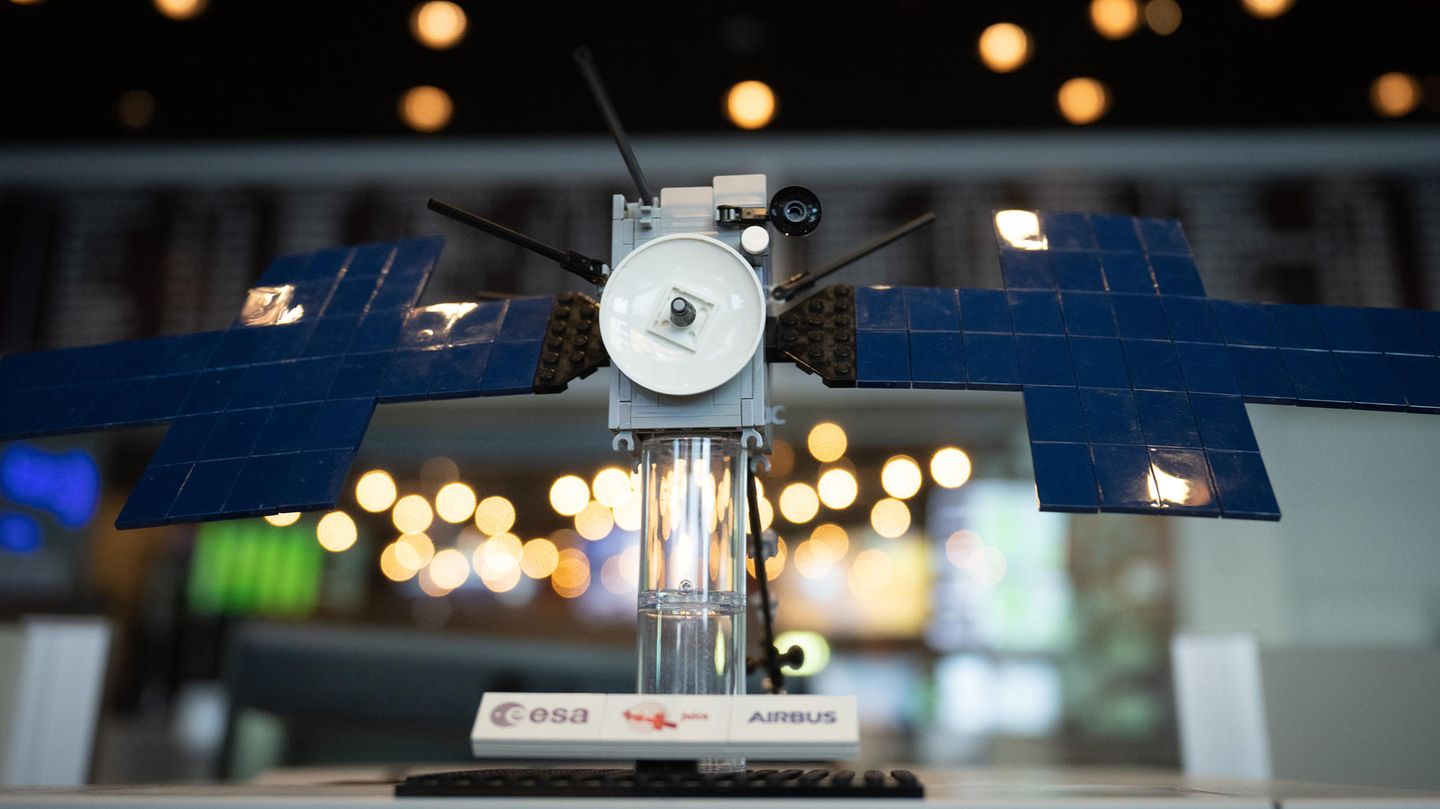European Space Agency Esa’s mission: “Juice” is to search for life in the solar system
A Lego model of the spacecraft “Juice” for the European Space Agency (ESA) Jupiter mission stands at the European Space Operations Center
© Sebastien Goulnot/DPA
With the “Juice” probe, the European Space Agency wants to travel to Jupiter, the largest planet in the solar system. The mission costs more than a billion euros and could provide answers to one of humanity’s big questions: Is there more life out there?
It is the giant among our planets. The moons orbiting it are the same size as the planets. It is now the target of the European Space Agency’s farthest mission yet: the gas giant Jupiter and its moons. Hundreds of millions of kilometers away, the question is whether there is life on Jupiter’s moons.
The “Juice” probe (Jupiter’s icy moon explorer) is scheduled to launch from Kourou Spaceport in French Guiana on April 13. With its 10 instruments on board, it should then look at mainly large moons, because there is water under a kilometer-thick crust of ice. “There are three moons that have oceans, and in fact they have a lot of water,” says mission engineer Angela Dietz of the European Space Agency’s Control Center in Darmstadt. This is where the mission control, which will cost more than one billion euros, will take place in the coming years.
Esa seeks more life in the solar system
Europa, Callisto and Ganymede are the moons that scientists want to look at since 2031, after the probe’s many-year journey. For the three moons, the researchers hypothesize that there are seas under the ice. Life conditions can be met there. Scientists assume you need water, you need energy, you need stability over several million years, Dietz explains. “Europa actually has the highest probability because it’s closer to Jupiter, which has more heat and energy.” So, in theory, ocean life could exist there. “We can just check if the basics are there,” Dietz says. Direct evidence of living things is not possible.
Certain elements that could serve as building blocks for molecules are needed for the emergence of life. There are opportunities on Europa and Ganymede, says Dietz. Using the 10 instruments, nine from European partners and one from NASA, various investigations can be carried out, including radar and laser measurements. Radar can also collect data under the ice layer. According to Dietz, you can go up to 19 kilometers through the ice.No such radar was present on previous NASA missions to Jupiter.
The “juice” is supposed to look for liquid water
The Institute for Planetary Research at the German Aerospace Center (DLR) in Berlin was also on board with these instruments. The Gala laser altimeter (Ganymede laser altimeter) is used to measure the surface of the Ganymede, says Hauke Hussmann, responsible for the Gala experiment. “We are examining ‘Ganymed’ almost completely.” This is important for understanding the evolution of the moon. “The second important aspect to add to the Jovian system is tidal deformation.” The moons will deform as they orbit the planet.
“The extent of this change over time can tell us whether there is liquid water inside, that is, whether there is a global ocean on Ganymede, as the model calculations predicted,” Haussmann says. With data and images from the “Janus” camera, in which the DLR played a major role, a 3D digital model of the moon, completely covered in ice, could later be created.
But how can liquid water exist hundreds of millions of kilometers from the sun? “Jupiter, with its enormous mass, has enormous tidal forces to exert,” Haussmann says. This leads to friction inside the moons and heat is generated as a result. “This is the energy source that plays an important role in the moons.”
Outrage
Decades Before Elon Musk: How German Engineer Lutz Kaeser Wanted to Reach for the Stars With His Rocket Company
It takes eight years for the probe to reach Jupiter
Before the probe can begin its work on Jupiter, it still has a long way to go. After launch, it will unveil its 85 square meter solar panels. Before heading out into the outer solar system, it will once again fly around Venus and three times around Earth on its eight-year journey to pick up speed.
According to Dietz, a trip through the asteroid belt between Mars and Jupiter is not a problem for the trip. According to the plan, the six-ton probe should reach Jupiter in 2031. There “juice” will fly across the moons. The probe will fly over Europa only twice. “The moon is close to Jupiter. Jupiter has a very high level of radiation, and the gravitational forces are very strong there,” Dietz says. This is also a matter of “juice” safety.
Finally, the probe will enter orbit around Ganymede, the largest of the moons and the only satellite with a magnetic field in the solar system. The probe is expected to crash-land there in September 2035.

“Subtly charming coffee scholar. General zombie junkie. Introvert. Alcohol nerd. Travel lover. Twitter specialist. Freelance student.”






More Stories
Intel offers a special graphics driver for “palaces”
Antibiotic-resistant bacteria mutated in space
Windows 11: Update brings ads in start menu